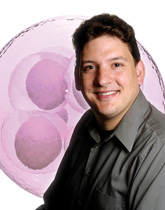
When Warren Ruder was nine years old, he discovered an old book at his elementary school. The book, published in the 1950s, is hardly light reading. It gives step-by-step instructions about how to create an electrical motor using cotton-insulated telephone wire. Despite his age, Ruder was enthralled with the pages and went right to work on the motor. His father, an avid reader with a love for science, encouraged his son’s curiosity. By 11, with his parents’ supervision, Ruder manhandled a circular saw to further his universe-exploring experiments.
Nearly two decades later, Ruder’s work has gone from his parents’ Phoenix, Ariz., garage to Hamerschlag Hall’s Cell Biomechanics Lab. Now 27, Ruder is a PhD student in biomedical engineering (advised by Professors Jim Antaki and Phil leDuc) and is a training fellow in biomechanics and regenerative medicine, a program jointly offered by Carnegie Mellon and the University of Pittsburgh. He applies his background in engineering and biology to study the effects that stem cells may have on the heart. Ideally, stem cells could regenerate the damaged heart tissue resulting from a heart attack.
His days with a circular saw may be behind him, but he still stays up late most nights working on his research. “It brings me back to that period,” Ruder says, “when my parents would drag me out of the garage, and my science experiments, to go to bed.” The National Science Foundation has taken notice of Ruder’s accomplishments. This summer, he was invited to join 500 international students for an annual meeting of Nobel Prize Laureates in Lindau, Germany.
Ruder has moved out of the garage.



